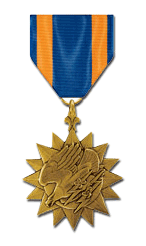 Establishing Authority
Establishing Authority
The Air Medal was established by Executive Order 9158 signed by President Franklin D. Roosevelt on May 11, 1942.
Effective Dates
The Air Medal is retroactive to September 8, 1939.
Criteria
The Air Medal may be awarded to individuals who, while serving in any capacity with the Armed Forces, distinguish themselves by heroism, outstanding achievement, or by meritorious service while participating in aerial flight, but not of a degree that would justify an award of the Distinguished Flying Cross.
Order of Precedence
The Air Medal is worn after the Bronze Star Medal and before Joint Service Commendation Medal. For Air Force personnel it is worn before the Aerial Achievement Medal.
Devices
- Army: Subsequent decorations of the Air Medal are denoted by bronze award numerals displayed on the medal and ribbon. The Army origninally used oak leaf clusters, however changed to numerals during the Vietnam War when the number of Air Medals awarded became too large to be annotated on a single ribbon. The Army also awrds the Air Medal with a valor "V" device.
- Air Force: Subsequent decoratins of the Air Medal are denoted by oak leaf clusters. The Secretary of the Air Force approved the award of the "V" device for valor to Air Medals awarded for heroism effective October 21, 2004. It applies to all air Force members, retirees and veterans, but this change is not retoractive to any earlier date; only decorations approved on or after October 21, 2004 are affected by this policy change.
- Navy and Marine Corps: There are two types of Air Medal awards: "individual" for singular meritorious acts and "strike/flight" for participation in sustained aerial flight operations. Bronze strike/flight numerals denote "strike/flight" awards.
-
Only personnel under flight orders are eligible to receive the strike/flight award of an Air Medal. Officers in the rank of captain (or colonel in the Marine Corps) are not eligible for award of the Air Medal on a strike/flight basis unless the sorties they fly are required in the performance of their regular duties.
- "Strikes" are sorties that deliver ordnance against the enemy, land or evacuate personnel in an assault, or in which personnel are engaged in search and rescue operations. The distinguishing feature of a strike is that it encounters enemy opposition.
- "Flights" are sorties that deliver ordnance against the enemy, land or evacuate personnel in an assault, or in which personnel are engaged in search and rescue operations. The distinguishing feature of a flight is that although it takes place in a nominally hostile environment, it does not encounter enemy opposition.
- As of September 27, 2006, gold award numerals are used to denote subsequent "individual" Air Medals. This is a return to the standard used before November 22, 1989. In the inteval betwen Novembver 22, 1989 and September 27, 2006, gold and silver award stars denoted subsequent "individual" Air Medals. for "individual" Air Medals, the valor "V" device may be authorized.
- Coast Guard: Subsequent awards are denoted by gold and silver stars. There are no additional devices authorized on the Coast Guard Air Medal.
Designer and Sculptor
The Air Medal was designed and sculpted by Walker Hancock.
First Recipient
The first recipient of the Air Medal was not recorded.
Description and Symbolism
Obverse
The obverse is a bronze compass rose of sixteen points and is one and eleven sixteenths inches in circumscribing diameter. The compass rose is suspended by a fleur-de-lis. In the center of the obverse there is an eagle volant, swooping downward and carrying a lighting bolt in each talon.
The compass rose reflects the global capacity of American air power, represented by the American bald eagle. The lightning bolts in the eagle's talons allude to the ability of the United States to wage war from the air. The Fleur-de-lis, the heraldic symbol of nobility, represents the high ideals of American airmen.
Reverse
The points of the compass rose on the reverse are modeled with the central portion plain for inscribing the recipient's name.
Ribbon
The ribbon is predominantly ultramarine blue with two orange-gold stripes just inside each edge and were selected because they were the colors of the Army Air Force.